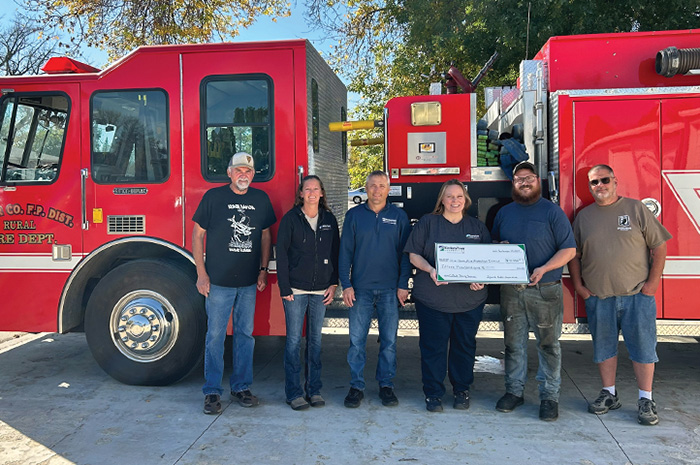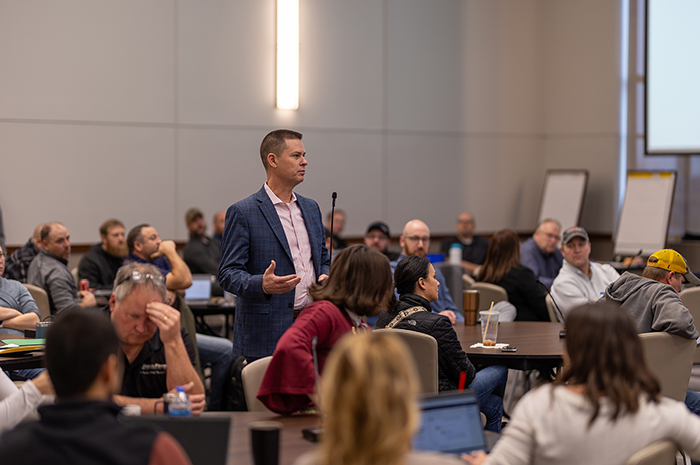Fresh power in the old power plant
A new Grand Forks research facility is unearthing an energy future in Minnkota’s energy past.
Harry Feilen has swapped a lot with the folks at Minnkota Power Cooperative from his office in the former 1822 Mill Road power plant. After moving in a year and a half ago, the site of the University of North Dakota’s (UND) Drilling & Completion Labs (DRACOLA)/Research Facility is almost fully finished within the walls of Minnkota’s old home. Feilen, DRACOLA’s director, has reached out to the prior residents for electrical wiring insight, boiler advice and – to find his mail.
“I’ve had a package or two delivered over there for me, and they’ve had a package or two delivered here,” said Feilen, explaining that mail carriers were accustomed to Minnkota’s long history there before the cooperative moved across town.
Beyond expertise and expedited parcels, UND and Minnkota have been sharing something else – the drive to enhance and fortify the energy industry in North Dakota.

The creation of the DRACOLA/Research Facility allows students, energy researchers and industry to work together to find solutions to challenges in the oil fields and coal mines, while also discovering new opportunities in emerging fields like rare earth elements processing, carbon capture and storage, and wind power.
The centerpiece of the research and training facility is DRACOLA’s full-scale drilling rig, donated to UND’s Petroleum Engineering Department by TerraTek founder Sidney Green. The massive rig (one of the world’s largest of its kind) and its accessories were shipped to Grand Forks from Salt Lake City on 11 separate semis in 2019. When running a full test, the setup can consume a significant amount of electricity from provider Nodak Electric Cooperative.
DRACOLA found its home in the retired power plant because of a concurrent search for a facility to house UND’s blooming rare earth elements pilot plant. Minnkota’s old building had the space, location and infrastructure needed for the two large projects and more.
“I saw the space and thought, it’s perfect for this drill rig, and we can part the building out and share rent with others so not all the burden fell on one entity,” Feilen said.
The 33-foot-tall DRACOLA rig was reassembled by Feilen and his team in a 50-foot high-bay corner of the building. There were no blueprints to follow – only a series of printed photos of the completed project. Now that the system is assembled, it has become a valuable tool for learners of all levels.
“We’re working with a couple of industry partners who are willing to send their first-time employees here for a month. They want their new hires to work with DRACOLA, get their hands on some of the equipment, get the terminology down and see where the safety aspects are,” Feilen explained. “And when students leave here and go out to the real world, I want them to have seen the same things.”
The hands-on rig has solidified UND’s place among the top petroleum engineering programs in the country, currently boasting a nation-leading 80 Ph.D. students. Feilen says teams from Texas have toured the facility and have noted that even their oil-rich state doesn’t have that caliber of experiential training. And DRACOLA’s reach isn’t limited to the oil and gas fields. It could be the catalyst for the leaders of an evolving energy landscape.
“When we start getting into more renewables, when we start getting into geothermal energy and CO2 storage, we’ll have to drill down and tap these holes for that. That’s where we can come in and help and say, ‘This would be your best practice to start, and adjust from there,’” Feilen said.
Extracting opportunity
Alongside DRACOLA, the other star of the Research Facility is the impressive rare earth elements extraction pilot plant, an IES project that has seen rapid development over the past five years. Minnkota has joined the Department of Energy and other partners in supporting the initiative, which could truly strengthen America’s lignite coal industry.

Rare earth elements are found in coal and their defining feature is high-powered, permanent magnetization that is being utilized more and more in modern living – in wind turbines, electric vehicles, disc drives and more. Right now, the U.S. produces virtually zero of its own rare earths, which could become a fairly large problem.
“For instance, fighter jets won’t be able to be constructed without these,” explained Nolan Theaker, IES research engineer and technical lead for rare earth and critical materials. “By trying to develop domestic supplies of these rare earths, you can significantly reduce foreign dependence, particularly in these defense-critical and energy-critical fields.”

Much of the world’s rare earth processing requires a complicated extraction procedure. Theaker’s team is using the pilot-scale system to test a simpler method that uses a dilute acid to strip off the rare earths in a cheaper, more environmentally friendly manner.
“When we extract the rare earths, we also extract other elements that are typically problems for power producers. For North Dakota lignite in particular, sodium is one of the big ones,” he said. “So we make a cleaner-burning fuel, there are fewer fouling constituents in it and it makes it a lot easier to convert for power.”
The state of North Dakota is the ideal scene for the research, and an even better launching pad for bringing the U.S. into the rare earths fold.
“One of the big benefits we have going for us is we have the mining infrastructure already in place for coal, and lignite in particular,” said Director of IES Dan Laudal. “In most places, if you have to go permit a new mine, it takes years to get a permit, and you have to go through and spend all the money to build out that infrastructure.”
The initial 2016 Department of Energy award to examine this process turned into Laudal’s Ph.D. dissertation, and he started the research in 60-gram batches in beakers. Five years later, the pilot plant will be processing a half a ton of lignite coal per hour. But it’s only a start.
“If we can get a full-scale plant in this region that could take the North Dakota lignite and put it through the process that this team is developing, that would have great implications for Grand Forks and the entire state of North Dakota,” Feilen said.

Future of energy
The facility now employs several graduate students seeking advanced degrees and Ph.D.s who understand the research’s potential. Brittany Rew is pursuing her master’s degree in chemical engineering and has been working with IES on the rare earths project since 2016. “I was involved when it was in the beaker scale,” she said. “Now, we’re moving things forward, and it’s all so new and exciting.”
“Being able to have pilot plant experience and chemical plant experience is really in demand for recent graduates and, generally, in the chemical engineering industry,” Theaker said. “It’s now something we have on campus that we can leverage.”

UND will hold a grand opening event for the DRACOLA/Research Facility during Homecoming Week in October. It will be a chance for industry, alumni, and current and prospective students to experience DRACOLA, the rare earths pilot plant and the building’s other energy research components, including a large wind tunnel and a slurry loop to study fluid properties of drilling.
There’s more space available in the old Mill Road facility, so Feilen says expansion is likely as the list of lab projects grows to meeting the growing promise of the industry. When that time comes, he knows he’ll have a supportive neighbor on the line.
“It’s been great having Minnkota as a partner on all of this,” he said. “It’s just another resource we can tap into.”
MAIN IMAGE: UND researchers, students and industry partners all use the research space to gain knowledge in the field. Left to right: Eric Kolb, Microbeam Technologies; Nicholas Dyrstad-Cincotta, IES research engineer; Brittany Rew, UND chemical engineering graduate student. (Minnkota/Michael Hoeft)
...



